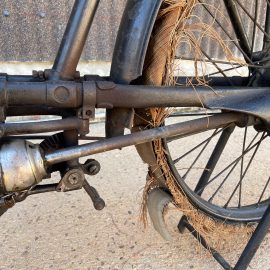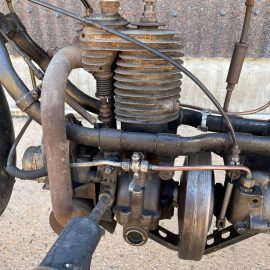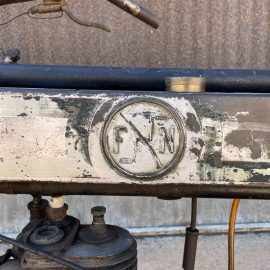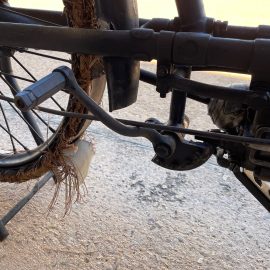
21 Dec On Yer Bike: 1914 FN Model 285
This month, FMM Curator Wayne Harley reveals a rare and unmolested Belgian motorcycle that poses the question – restore or not restore? Read on, and please give Wayne your thoughts…
The Franschhoek Motor Museum has some wonderful unrestored and exceptional historic gems in its motorcycle collection, one of which is a totally original single-cylinder 1914 FN Model 285. I’ve often wanted to haul out this beautiful artefact and get it into the workshop as a restoration project but could never allow myself to disturb the machine’s rich 107-year-old patina. Back in 1975, this little FN was one of the first motorcycles to be acquired by the FMM’s forerunner, the Heidelberg Motor Museum. It came from the Patrick Chapman Collection out of the UK, and has formed part of the museum’s unseen collection ever since, so it is my honour to now share this bike’s story with you.
La Fabrique Nationale d’Armes de Guerre (FN, for short) came into being in 1889 in the city of Herstal, Belgium, and was primarily founded to produce rifles for the Belgian military, thanks to a government contract and an order for 150 000 Mauser rifles. I wonder how many of South African infantry troops (‘troopies’) of the ’70s and ’80s will remember the FN (FAL) rifles that later became the trusted R1/2 made under licence in South Africa? But that is a totally different story…
By 1900 the FN Company had diversified into bicycle, motorcycle, car and truck production with its first motorcycle being nothing more than a small 130 cc motor strapped to a bicycle. By December that year, their first full motorcycle was released, also powered by a 133 cc single-cylinder engine. Further development was quick, and soon a 188 cc and 224 cc engines became available. Then in 1904, a remarkable four-cylinder 393 cc in-line model was presented at the First World ‘Salon de l’Auto’ in Paris. This introduction followed MF Osmont completing an epic journey around Europe to promote the new machine with its single-speed, shaft-driven rear wheel being the first of its kind in the world. The four-cylinder FN was the premier motorcycle in the company’s line-up and appeared in a number of guises until the end of 1923, superseded by the 748 cc M50 Model – one of the most gorgeous pre-war motorcycles ever released – until four-cylinder production stopped in 1926.
It is during this period of the company’s history that the motorcycle being featured in this article made its appearance. FN released the Model 285 in 1912 and it was powered by a 285 cc four-stroke engine producing 1,8 kW which was also FN’s first single-cylinder engine to no longer use an atmospheric inlet valve system. The Model 285 was also the first small-capacity motorcycle in the FN line-up to have a two-speed gearbox with a handlebar-mounted clutch lever and foot-operated rear brake. Shaft drive was now standard on all the small-capacity motorcycles as well as the bigger fours. Then in 1914 the pedal starting system was replaced with a more conventional kick-starter. The Model 285 was also one of the lightest motorcycles in the FN range, with a dry weight of only 58 kg.
By this stage in history, FN had not only acquired a reputation for quality and reliability but also for producing speed machines. In 1913, British TT rider RO Clark set a world record on a Model 285 with an average speed of over 70 km/h.
The outbreak of WWI and the German invasion of Belgium almost saw FN’s demise, but in a strange turn of events, the German armed forces needed the company’s motorcycles for their dispatch riders. In reality, this requirement kept the company going as FN was forced into producing motorcycles for the German war effort. By 1919, after hostilities ended, the company was able to resume producing vehicles again.
Over the next five decades, La Fabrique Nationale would go on to produce some stunning and memorable motorcycles, cars – and even trucks – with the last motorcycle being produced in 1967. By that time the company had already moved away from full-blown motorcycles into the moped market. By the end of 1968, the FN company had returned to arms production.
So, it will be interesting to get reader’s opinions to determine if the Franschhoek Motor Museum should restore this motorcycle completely or leave it showing the patina of time as a testament to how well it has survived. Please let us know…







